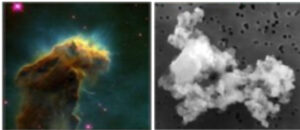 Light scattering theory in the Transition matrix (T-matrix) formalism has proved to be a very powerful approach to study light scattering by non spherical and non homogeneous particles. The T-matrix method gives an accurate solution to the problem, with no need to use approximations and with a very satisfactory agreement with experimental results. The flexibility and elegance of the mathematical formalism together with the efficiency of the developed computational approach make the T-matrix a very good choice especially when dealing with light scattering by aggregated particles.
Light scattering theory in the Transition matrix (T-matrix) formalism has proved to be a very powerful approach to study light scattering by non spherical and non homogeneous particles. The T-matrix method gives an accurate solution to the problem, with no need to use approximations and with a very satisfactory agreement with experimental results. The flexibility and elegance of the mathematical formalism together with the efficiency of the developed computational approach make the T-matrix a very good choice especially when dealing with light scattering by aggregated particles.
Optical trapping, plasmonics, and complex structures. The T-matrix method has been applied successufully to a wide range of problems, going from optical trapping modelling to plasmonics, and more recently to the study of the optical behaviour of complex nanostructures. The theory of optical trapping of nonspherical particles in the focal region of a high-numerical-aperture optical system enables us to accurately calculate optical forces on optically trapped samples at the nanoscale and mesoscale, with a very good agreement between computational results and experimental evidence.
The T-matrix approach also finds application in plasmonics, in the modelling of the peculiar optical properties of metal nanoparticles (MNPs) in the near and far-field. Such properties are mainly due to the fact that MNPs support localized surface plasmon resonances, that are excited when an incident electromagnetic radiation creates collective coherent oscillations of the particle free electrons. Such plasmon excitations result in a large enhancement of the electromagnetic field around the nanoparticle, yielding both a strong absorption and scattering of light by the nanoparticle at the plasmon resonance. Through the T-matrix method, we are able to accurately study the plasmon coupling in metal dimers and nano-aggregates and the optical behaviour of nanoshell particles made by a dielectric core covered with a metal shell.
Light scattering and localization effects in complex structures as nanowires or polimer nanofiber mats have been also investigated modelling such systems as large aggregates of particles. We have also investigated the correlation between optical behaviour and fractal structure.
Interstellar Dust. Dust is an ubiquitous inhabitant of the interstellar medium and leaves an unmistakable signature in its optical properties and physico-chemical evolution. Although there is little direct knowledge of the true nature of interstellar dust grains, strong evidences point toward the possibility that such grains are composites of many small monomers (mainly made of silicates and carbonaceous materials). Such monomers may often appear as stratified structures in which carbon is deposited slowly on the surfaces of silicate cores. We study the optical properties and the temporal evolution of such dust grains through the multipole fields and the T-matrix approach. We also explore the possible role of composite fluffy dust grains, covered by ice mantles, in igniting an extraterrestrial prebiotic chemistry.
Labs involved in these research activities
People
- M.A. Iatì, O. M. Maragò, Rosalba Saija (Unime – associated personnel)
